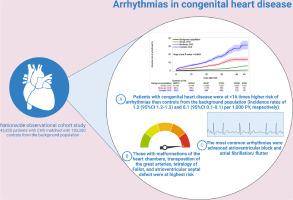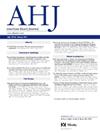Arrhythmias in congenital heart disease: A nationwide cohort study
IF 3.7
2区 医学
Q1 CARDIAC & CARDIOVASCULAR SYSTEMS
引用次数: 0
Abstract
Background
As more patients with congenital heart disease (CHD) survive into adulthood, the population of adults with CHD is expanding. This trend is accompanied by an increasing incidence of complications, including arrhythmias. However, the long-term risk of arrhythmias remains sparsely investigated.
Methods
In this observational cohort study, all Danish patients with CHD born from 1977 to 2024 were identified using registries and followed from date of birth until the occurrence of arrhythmia, emigration, death, or end of follow-up (March 2024). The risk of arrhythmias was assessed among patients with CHD and compared to age- and sex-matched controls from the background population.
Results
A total of 45,820 patients with CHD (50.9% men) were identified and matched with 183,280 controls from the background population. During a median follow-up of 21.5 years, 2.6% of patients with CHD and 0.2% of controls developed arrhythmias—corresponding to incidence rates (IR) of 1.2 (95% CI 1.2-1.3) and 0.1 (95% CI 0.1-0.1) per 1,000 PY, respectively, and a hazard ratio (HR) of 16.4 (95% CI 14.4-18.7). The most common arrhythmias in patients with CHD were advanced atrioventricular block (IR 0.4 [95% CI 0.4-0.4] per 1,000 PY) and atrial flutter/fibrillation (IR 0.5 [95% CI 0.5-0.6] per 1,000 PY). Patients with malformations of the heart chambers, transposition of the great arteries, tetralogy of Fallot, and atrioventricular septal defect were at the highest risk of arrhythmias. Moreover, the risk of arrhythmias among those with ASD was not negligible. In patients with CHD, arrhythmia was associated with a significantly higher risk of death (HR of 6.9 [95% CI 5.9-8.1]).
Conclusions
Patients with CHD are at significantly higher risk of arrhythmias than the background population, and those with complex CHD are at particularly high risk. In patients with CHD, arrhythmia is associated with an increased risk of death. Additional studies are warranted to investigate how we can improve the diagnosis and management of arrhythmias in CHD.

先天性心脏病心律失常:全国队列研究。
背景:随着越来越多的先天性心脏病(CHD)患者存活到成年,患有先天性心脏病的成人群体也在不断扩大。伴随这一趋势的是包括心律失常在内的并发症发病率不断上升。然而,有关心律失常长期风险的研究仍然很少:在这项观察性队列研究中,通过登记册确定了 1977 年至 2024 年出生的所有丹麦先天性心脏病患者,并从出生日期开始进行随访,直至发生心律失常、移民、死亡或随访结束(2024 年 3 月)。对心脏病患者的心律失常风险进行了评估,并与背景人群中年龄和性别匹配的对照组进行了比较:共发现 45,820 名先天性心脏病患者(50.9% 为男性),并与 183,280 名背景人群中的对照组进行了配对。在中位 21.5 年的随访期间,2.6% 的冠心病患者和 0.2% 的对照组患者出现了心律失常,对应的发病率 (IR) 分别为每 1,000 人 1.2 例(95%CI 1.2-1.3)和 0.1 例(95%CI 0.1-0.1),危险比 (HR) 为 16.4(95%CI 14.4-18.7)。先天性心脏病患者最常见的心律失常是晚期房室传导阻滞(IR 0.4 [95%CI 0.4-0.4] per 1,000 PY)和心房扑动/颤动(IR 0.5 [95%CI 0.5-0.6] per 1,000 PY)。心室畸形、大动脉转位、法洛氏四联症和房间隔缺损患者发生心律失常的风险最高。此外,ASD 患者发生心律失常的风险也不容忽视。在患有冠心病的患者中,心律失常与显著较高的死亡风险相关(HR 为 6.9 [95%CI 5.9-8.1]):结论:患有冠心病的患者发生心律失常的风险明显高于其他人群,而患有复杂冠心病的患者发生心律失常的风险尤其高。在冠心病患者中,心律失常与死亡风险增加有关。我们有必要开展更多的研究,探讨如何改进对冠心病心律失常的诊断和管理。
本文章由计算机程序翻译,如有差异,请以英文原文为准。
求助全文
约1分钟内获得全文
求助全文
来源期刊

American heart journal
医学-心血管系统
CiteScore
8.20
自引率
2.10%
发文量
214
审稿时长
38 days
期刊介绍:
The American Heart Journal will consider for publication suitable articles on topics pertaining to the broad discipline of cardiovascular disease. Our goal is to provide the reader primary investigation, scholarly review, and opinion concerning the practice of cardiovascular medicine. We especially encourage submission of 3 types of reports that are not frequently seen in cardiovascular journals: negative clinical studies, reports on study designs, and studies involving the organization of medical care. The Journal does not accept individual case reports or original articles involving bench laboratory or animal research.
 求助内容:
求助内容: 应助结果提醒方式:
应助结果提醒方式:


